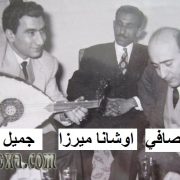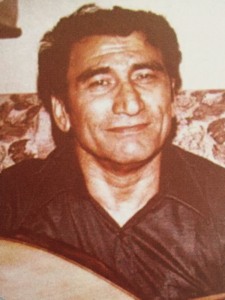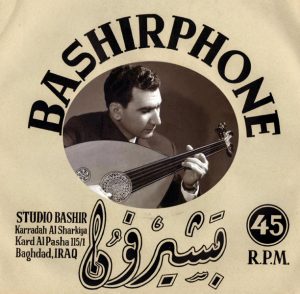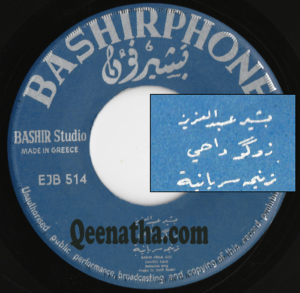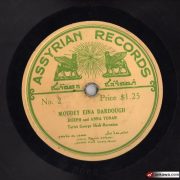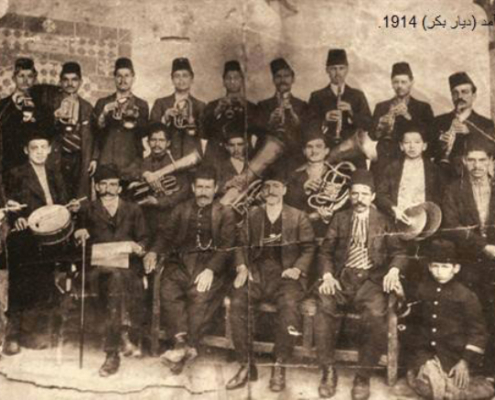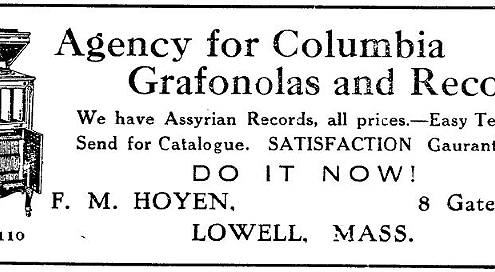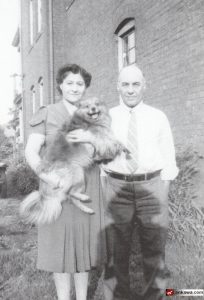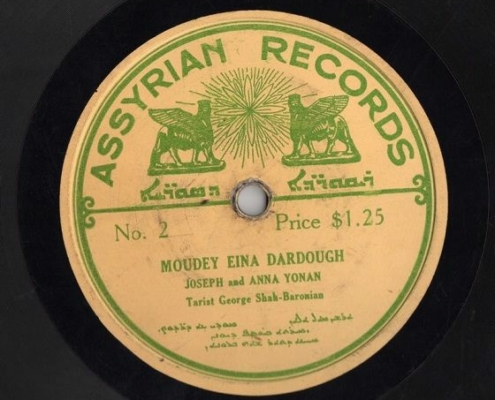جميل بشير وتاريخ الاسطوانات الموسيقية الاشورية في العراق
تنحدر عائلة بشير من جبال عبدين (محافظة ماردين) الواقعة في جنوب شرق تركيا حالياً ومابين النهرين الشمالية قديماً قبل رسم الحدود السياسية الحديثة, وعائلة بشير هي عائلة سريانية, انتقلت العائلة من تركيا الى الموصل عام ١٩٠١ ومن ثم انتقلت الى بغداد عام ١٩٣٧ دخل جميل بشير معهد الموسيقى في بغداد ودرس العود والة الكمان وكان من الدوره الاولى التي تخرجت من المعهد والذي اصبح لاحقاً معهد الفنون الجميلة. درس الة العود على يد الشريف محيي الدين حيدر (١٨٩٢-١٩٦٧), وثم تعلم على الة الكمان واتقنها بحرفية عالية, واصبح معلماً ومدرباً في المعهد في الاربعينيات والف الكثير من الالحان والمقطوعات الموسيقية الرائعة, وساهم في تطوير الاغنية العراقية والاشراف على الانتاج الغنائي والموسيقي في تلك الفترة. الف كتاب بجزئين وهو العود وطريقة تدريسه, ويعتبر من اهم الكتب الرائدة في تعلم العود في العراق والمنطقة, ويُدرس لحد الان في المعاهد الشرقية والغربية في العالم.
في عام ١٩٥٩ اسس جميل بشير في منطقة الكرادة في بغداد شركة عشتارفون لانتاج الاسطوانات ومن ثم غير اسمها الى شركة بشيرفون. وكانت هذة الشركة تنافس الاذاعة والتلفزيون العراقية في غزارة الانتاج والجودة.
سجل جميل بشير ارشيف الغناء العراقي في الخمسينات والستينات, وكان موسيقاراً يبحث دائماً عن الابداع, ومن ضمن الاسطوانات التي سجلها كانت بصوت والده بشير عزيز وهي تراتيل كنسية. واصدر اسطوانة لمقطوعاته الموسيقية بعد زيارته لفرنسا عام ١٩٧٣ تحت عنوان “ارابيسك” لشركة (إي.إم.أي) ونالت الاسطوانة الجائزة الاولى كأفضل البوم من بين عشرات الالبومات الشرقية.
يعتبر الموسيقار المرحوم جميل بشير من اهم الرواد الذين ساهموا في اغناء الخزانة الموسيقية والغنائية الاشورية, ولا اعتقد بأن هذا الشخص الوطني النادر اخذ نصيبه من التكريم للخدمة التي قدمها للتراث الغنائي الاشوري في وقت كانت فيه الاقليات تعاني التهميش والتعريب والاضطهاد السياسي, استطاع المؤلف السيد عبود زيتوني بتوثيق حياة الراحل الموسيقار جميل بشير وتأثيرة على الموسيقى الاشورية في كتابة الصادر في المانيا عام ٢٠١٥ بعنوان “الموسيقى الاشورية الحديثة”.
فقد ساهم الموسيقار جميل بشير في تسجيل وانتاج اكبر مجموعة اسطوانات لمطربين يعتبرون اليوم من رواد الغناء الاشوري, فقد كانت الاعراس والمناسبات يستحوذ عليها الطابع التراثي من حيث العزف على الزورنا (الناي) والطبلة والغناء بدون موسيقى في الاعراس والحفلات.
فقد اصدرت شركة عشتارفون اول اسطوانة حجرية للمطرب الراحل اوشانا يول ميرزا (١٩١٨-٢٠٠٩), اصدرها في الخمسينات ولاكن لانعرف في اي سنة بالتحديد لاننا لم نستطع العثور على نسخة من كتالوجات الشركة لحد الان, تعتبر اسطوانة اوشانا الحجرية من الاسطوانات النادرة ولم تكن معروفة بين اوساط هواة جمع الاسطوانات وعثرنا عليها قبل حوالي سنتين فقط. واستمرت الشركة بأصدار اسطوانات للمطرب اوشانا ميرزا حيث اصدرت الشركة ثمان اسطوانات له, اربع منها تحت اسم عشتارفون واربع منها تحت اسم بشيرفون اصدرتها الشركة بين الخمسينات والستينات.
كانت ساحة الغناء الاشوري بأمس الحاجة لمثل هذة التسجيلات التي ساهمت في ملء فراغ كبير كان يعانيه الاشوريون في العراق وبلاد الجوار ونلاحظ ذلك عن طريق العدد الكبير للنسخ الغير رسمية التي استنسختها على سبيل المثال شركات ايرانية لاسطوانات جميل بشير ففي احد الامثلة لاسطوانة اوشانا ميرزا قامت ثلاث شركات مختلفة في طبعها وبيعها في ايران
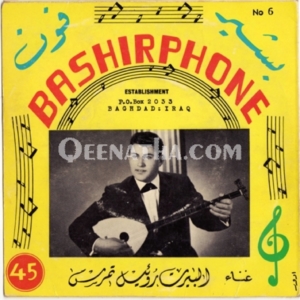 اصدرت شركة بشيرفون ايضاً اسطوانات للمطرب الراحل ملك الفلكلور الاشوري البرت رويل تمراس (١٩٤٤-٢٠١١) لاكن من الصعب تحديد عدد الاسطوانات التي اصدرتها الشركة للمطرب البرت تمراس ولاكن نتوقع ان تكون ست اسطوانات (سنگل) بلاستيكية, اصدرتها الشركة في الستينات, و احد تلك الاسطوانات للمطرب البرت رويل تمرس يغني في الكورس خلفه المطرب ادور يوسف بيبا وسركون جبرائيل في اول غناء لهم.
اصدرت شركة بشيرفون ايضاً اسطوانات للمطرب الراحل ملك الفلكلور الاشوري البرت رويل تمراس (١٩٤٤-٢٠١١) لاكن من الصعب تحديد عدد الاسطوانات التي اصدرتها الشركة للمطرب البرت تمراس ولاكن نتوقع ان تكون ست اسطوانات (سنگل) بلاستيكية, اصدرتها الشركة في الستينات, و احد تلك الاسطوانات للمطرب البرت رويل تمرس يغني في الكورس خلفه المطرب ادور يوسف بيبا وسركون جبرائيل في اول غناء لهم.
اصدرت شركة بشيرفون اربع اسطوانات (سنگل) بلاستيكية للمطرب الراحل الملقب بملك الغناء ادور يوسف بيبا (١٩٤٥-١٩٩٥) كانت هذة من سنة ١٩٦٢ الى ١٩٦٧. واصدرت الشركة ايضاً اسطوانتين للمغنية اليزابيث وزوجها ايشايا زيا عام ١٩٦٥ وايضاً اسطوانتين للمغنية افلين شمعون تضم اغنية نرجس نرجس.
وبهذا الكم من الاغاني استطاع اثراء المخزون الفني الاشوري بأجمل الاغاني التي اصبحت جزءاً من التراث وساهمت في نشر وتوثيق الاغنية الاشورية واكتشاف مواهب اصبحت من المع نجوم الغناء الاصيل
مُنير چیري
سدني – استراليا
واحد العاملين على موقع
Qeenatha.com

